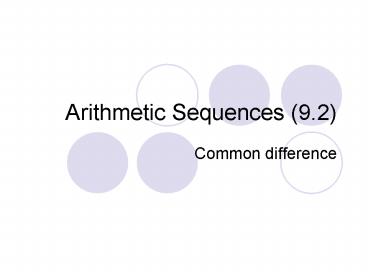Arithmetic Sequences (9.2) - PowerPoint PPT Presentation
1 / 24
Title:
Arithmetic Sequences (9.2)
Description:
Arithmetic Sequences (9.2) Common difference SAT Prep Quick poll! Start with calculator review of sequences and partial sums There are three handy hand-outs ... – PowerPoint PPT presentation
Number of Views:197
Avg rating:3.0/5.0
Title: Arithmetic Sequences (9.2)
1
Arithmetic Sequences (9.2)
- Common difference
2
SAT Prep
- Quick poll!
3
Start with calculator review of sequences and
partial sums
- There are three handy hand-outs
- Sequences on the TI-84/84 Plus
- Partial sums on the TI 84/ 84 Plus
- Sequence mode on the TI 84/ 84 Plus
- Lets see what sort of info they contain.
4
A sequence next
- Give the first five terms of the sequence for
- a1 2
- an1 an 5
- What is the pattern for the terms?
- What is a possible explicit formula?
5
A sequence next
- Give the first five terms of the sequence for
- a1 2 2, 7, 12, 17, 22
- an1 an 5
- What is the pattern for the terms?
- A common difference of 5.
6
Arithmetic sequences
- If the pattern between terms in a sequence is a
common difference, the sequence is - arithmetic. The difference is d.
- Recursive
- a1
- an1 an d So, d an1 - an
7
Arithmetic sequences
- If the pattern between terms in a sequence is a
common difference, the sequence is - arithmetic.
- Explicit
- an a1 (n-1) d
- (In other words, find the nth term by adding
(n-1) ds to the first term.)
8
Use it
- Give the first five terms for the sequence
- an 2 (n-1) 9
- Write the recursive formula.
9
Use it
- Give the first five terms for the sequence
- an 2 (n-1) 9
- 2, 11, 20, 29, 38
- Write the recursive formula.
- a1 2
- an1 an 9
10
Use it
- an 2 (n-1) 9
- Find the 10th term of the sequence.
11
Use it
- an 2 (n-1) 9
- Find the 10th term of the sequence.
- a10 2 (10 - 1) 9
- 2 (9)9
- 2 81
- 83
12
Use it
- If the fourth term of a sequence is 5 and the
ninth term is 20, find the sixth term. - The key is to find the values for the first term
and d. - Start by writing the equations
- 20 a1 (9 - 1) d 20 a1 8d
- 5 a1 (4 - 1) d 5 a1 3d
13
Use it
- If the fourth term of a sequence is 5 and the
ninth term is 20, find the sixth term. - Next, use a system of equations to solve for d
- 20 a1 8d
- -(5 a1 3d)
- 15 5d
- 3 d
14
Use it
- If the fourth term of a sequence is 5 and the
ninth term is 20, find the sixth term. - If d 3, we can find the first term
- 5 a1 (4 - 1) 3
- 5 a1 9
- a1 -4
15
Use it
- If the fourth term of a sequence is 5 and the
ninth term is 20, find the sixth term. - If d 3, and a1 -4 we can find the explicit
equation - an -4 (n-1) 3
- And the sixth term is a6 -4 (5)3 11.
16
Partial sums
- Add the first 10 terms of our first sequence.
17
Partial sums
- Add the first 10 terms of our first sequence.
- 2 7 12 17 22 27 32 37 42 47
- How long did that take? Want a short cut?
18
Partial sums
- Add the first 10 terms of our first sequence.
- 2 7 12 17 22 27 32 37 42 47
- 47 42 37 32 27 22 17 12 7 2
- 49494949 10(49).
- We want only half of this, so the sum is 5 (49),
or 5(first term last term), which is 245.
19
Partial sums
- In general, the partial sum for an arithmetic
sequence is - Sn n/2 (a1 an)
- or, if we substitute our explicit formula for
an - Sn n/2 (2a1 (n - 1) d)
20
Partial sums
- In general, the partial sum for an arithmetic
sequence is - Sn n/2 (a1 an)
- Sn n/2 (2a1 (n - 1) d)
- Test it with our sequence n 10, a1 2, a10
47 - S10 10/2(2 47) 5(49) 245
21
Partial sums
- Find the sum of the first 100 positive integers.
22
Partial sums
- Find the sum of the first 100 positive integers.
- This problem was posed to Karl Friedrich Gauss
(1777-1855) in third grade, and he determined the
pattern. - S100 100/2(1100) 50(101) 5050
23
Partial sums
- Find the sum of the first 50 positive even
integers. - How does this compare to the sum of the first 100
positive integers?
24
Partial sums
- Find the sum of the first 50 positive even
integers. - How does this compare to the sum of the first 100
positive integers? Lets look at it in summation
notation. - S50 50/2(2 100) 25(102) 2550

